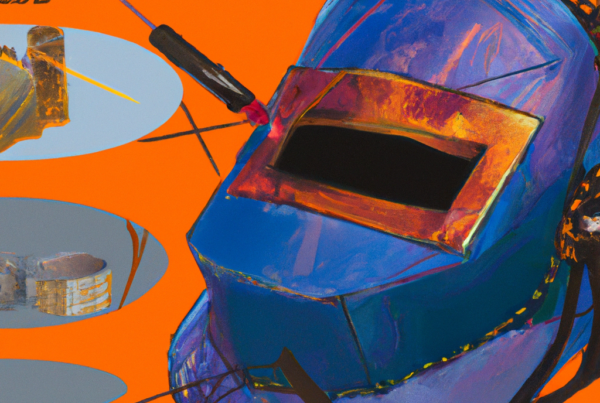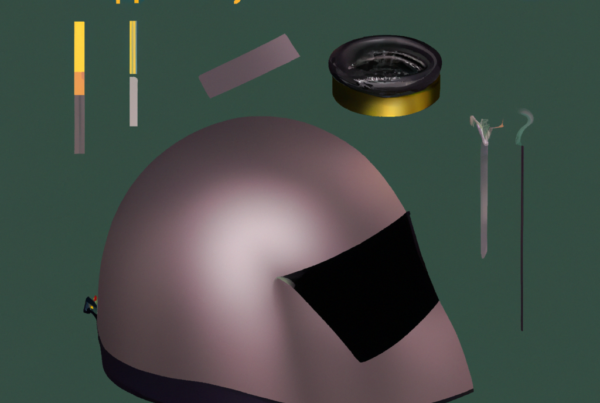If you’re in the welding industry, you know how important it is to have the right safety gear. A welding helmet is a key piece of this protective equipment, so it’s critical to make sure it’s in good working condition. But how can you tell if your welding helmet is functioning properly? In this article, we’ll explore the various signs to look for that will indicate if your welding helmet is working correctly. We’ll also discuss what to do if you find that your helmet is not functioning as it should. So, if you want to make sure you’re safe when you’re welding, stick around and read on!

What is the purpose of a welding helmet?
The purpose of a welding helmet is to protect the welder from exposure to harmful light and radiation. It also serves as a shield against sparks and debris that may be generated during the welding process. A good welding helmet should provide full coverage of the face and neck and have a dark green filter to reduce the amount of harmful light and radiation.
To tell if a welding helmet is working properly, check the following:
- Check the lens for any cracks or damage
- Make sure the filter is in the correct position
- Check if the shield has been properly adjusted to fit your face and neck
- Confirm the headgear is secure
- Check the battery and replace it if necessary
- Confirm that the auto-darkening filter is working by turning it on and off
- Check the welding helmet for any signs of wear and tear
It is important to regularly check the welding helmet for any signs of wear and tear and replace it if necessary. This will ensure that the helmet is providing adequate protection and is in good working order.
How does a welding helmet work?
A welding helmet is a type of headgear used when performing certain types of welding. It protects the wearer’s eyes and face from sparks, intense light, and heat. The most common type of welding helmet is a passive helmet, which uses a special filter lens to protect the eyes and face from the infrared and ultraviolet radiation created by the welding arc.
To tell if a welding helmet is working, check the following:
- Make sure the helmet is securely fastened to your head.
- Check to see if the lens of the helmet is not scratched or damaged.
- Look for any signs of wear or tear on the helmet.
- Make sure the helmet is properly ventilated.
- Check the filter lens for any signs of fading or discoloration.
- Test the filter lens by looking at a bright light or weld.
If all of the above checks out, then the welding helmet should be ready for use.
What safety features should the welding helmet have?
It is important to ensure that a welding helmet is working properly before beginning a welding job. Here are some safety features that a welding helmet should have to ensure that it is working correctly:
- A clear, distortion-free view of the welding area.
- A protective lens to protect the eyes from intense light.
- A face shield made of a strong, heat-resistant material.
- An auto-darkening filter that reacts quickly to sudden changes in light.
- A secure fit to prevent the helmet from slipping off during welding.
- A comfortable fit and adjustable straps.
- A secure latching system to prevent the helmet from accidentally coming off.
- An adjustable shade setting to adjust the level of protection for different types of welding.
In addition, it is important to check for any signs of wear and tear on the helmet, such as cracks or dents. If any of these features are missing or faulty, the helmet should be replaced or repaired before use.
What are the dangers of not wearing a welding helmet?
Not wearing a welding helmet can be dangerous and can cause serious injuries. The following are some of the potential risks associated with not wearing a welding helmet:
- Exposure to high levels of ultraviolet (UV) radiation, which can cause skin burns, eye damage, and even blindness.
- Exposure to intense visible light, which can cause temporary or permanent blindness.
- Injuries caused by flying sparks and hot metal.
- Inhalation of toxic fumes and gases.
- Damage to hearing from loud noise.
To ensure your safety while welding, it is important to wear a properly functioning welding helmet. Here are some tips on how to tell if a welding helmet is working:
- Check that the lens is clear and free from cracks or damage.
- Make sure the helmet fits snugly and securely.
- Check that the headgear is adjustable and comfortable.
- Make sure the viewing area is large enough to provide adequate protection.
- Check that the lens is dark enough to protect against UV and intense visible light.
What are the signs of a faulty or malfunctioning welding helmet?
Welding helmets are an essential piece of safety equipment for welders. To ensure that your welding helmet is in good working condition, you should regularly check for signs of wear or damage. Here are some signs that your welding helmet may be malfunctioning:
- If your helmet is slow to darken, or if it takes too long to lighten after you finish welding, this could be a sign of an issue that needs to be addressed.
- If the helmet does not consistently darken or lighten at the appropriate times, it could be a sign of a malfunctioning helmet.
- If the helmet lens is fogging up, or the auto-darkening feature is not working properly, this could be a sign that the helmet needs to be replaced.
- If the helmet is cracked or dented, this could be a sign that the helmet is not functioning properly and should be replaced.
It is important to check your welding helmet regularly for signs of wear or damage. If you notice any of these symptoms, you should replace your welding helmet as soon as possible to ensure your safety.
How can I inspect a welding helmet for functionality?
In order to inspect a welding helmet for functionality, it is important to check the following:
- Visor: Inspect the visor for damage, cracks, and discoloration. Make sure the visor is free from damage and is in good condition.
- Viewing window: Check the size and shape of the viewing window. It should be of the correct size and shape for the application.
- Lens: Check the lens for clarity and any signs of damage. Make sure the lens is clean and free from scratches or cracks.
- Hinges: Check the hinges to make sure they are secure and functioning properly.
- Light sensitivity: Test the light sensitivity of the welding helmet. You should be able to adjust the light sensitivity to the correct level for the job.
- UV protection: Make sure the welding helmet provides adequate protection from UV rays. Look for a rating of at least 14 on the welding helmet.
By following these steps, you can determine if a welding helmet is working properly. If any of these items are not working correctly, the welding helmet should be replaced to ensure safe and effective welding.
What should I look for when inspecting a welding helmet?
When inspecting a welding helmet, there are a few important things to look out for in order to ensure it is working properly.
First, check the overall condition of the helmet. Make sure there are no cracks or damage that could compromise its integrity. Inspect the lens to make sure it is undamaged and free of any debris. The interior should also be free of any obstructions and the headgear should be adjustable.
Next, check the helmet’s electronics and power sources to make sure they are functioning properly. Make sure the battery is charged and that the helmet is receiving power. Test the controls to make sure they are working correctly.
Finally, inspect the helmet’s lens and filter. The lens should be clean and clear with no scratches or other damage. The filter should be free of any contamination and should be replaced if it is too old or worn out. Ensure that the filter is rated for the type of welding you are doing and that the shade level is appropriate. The filter should also have an output of no more than 120 amps to ensure proper protection from bright sparks and fumes.
How can I test a welding helmet to make sure it works?
Testing a welding helmet to make sure it is working correctly is an important task for any welder. Here are a few steps you can follow to make sure your welding helmet is working correctly:
- Visually inspect the welding helmet for any damage or defects. Pay particular attention to the filter lens, ensure that it is not cracked, scratched or discolored.
- Make sure the helmet is securely attached to the headgear before you start welding. If the fit is not right, you will not be able to see correctly.
- Check the shade level of the helmet. Most helmets are adjustable from shade level 8 to shade level 13. Make sure that the shade level is appropriate for the type of welding you are doing.
- Put the helmet on and check to see if the lens darkens when you strike an arc. The lens should darken within a few seconds of striking the arc.
- Check the viewing area of the helmet. The viewing area should be clear and free of distortion.
- Check the sensitivity of the lens. The lens should darken when exposed to the arc, and should not be too slow or too fast.
Finally, check the battery. If your welding helmet has an auto-darkening feature, make sure the battery is charged and working correctly. It should be able to last several hours of welding.
What are the risks of using a welding helmet that doesn’t work?
If a welding helmet is not working properly, it can cause serious consequences. Here are some of the risks of using a welding helmet that doesn’t work:
- Injury from flying sparks or bright light: A welding helmet that isn’t working properly may not provide adequate protection from the intense light and sparks created during welding, leading to injuries.
- Burns: A defective welding helmet may not adequately protect the face and neck from the heat of the welding arc, leading to painful burns.
- Incomplete welds: With an inadequate view of the welding surface, welders may be unable to properly complete their welds, leading to quality issues.
It is important to make sure that your welding helmet is in good working condition before beginning any welding project.
How Does the Plating Process Impact the Performance of a Welding Helmet?
The plating process explanation is essential in understanding how it impacts the performance of a welding helmet. The plating coating applied to the helmet serves as a protective layer, enhancing its durability and resistance to heat, chemicals, and impacts. This prolongs the helmet’s lifespan and ensures optimal performance even in harsh welding conditions.
What should I do if my welding helmet isn’t working properly?
If your welding helmet isn’t working properly, there are a few steps you can take to diagnose the issue and fix it. Here’s how to tell if a welding helmet is working correctly:
- Check the power source. Make sure your welding helmet is plugged in and the power supply is working.
- Inspect the lens for any scratches or cracks. If the lens is damaged, replace it.
- Test the welding helmet. Strike an arc and observe if the lens darkens as it should.
- Check the sensitivity settings. Make sure the delay and darkening settings are properly adjusted.
- Check the battery. If the helmet is battery-powered, make sure it is fully charged and working.
If the issue persists, it may be time to replace your welding helmet. Consult the manufacturer’s instructions for more detailed troubleshooting advice.



